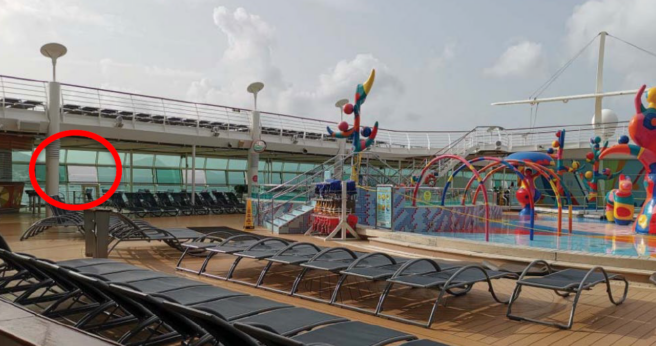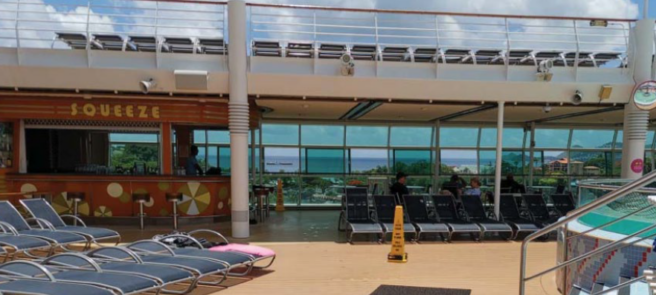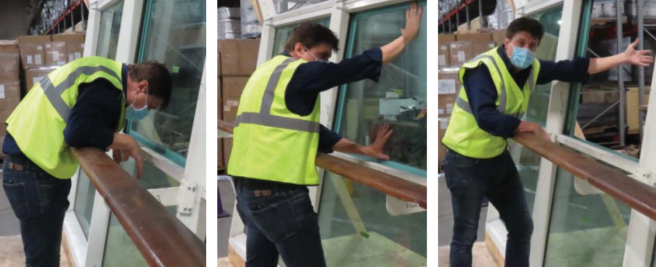Yesterday, the eleventh Circuit Court docket of Attraction despatched the wrongful demise case in opposition to Royal Caribbean Cruises by the mother and father of Chloe Weigand whose grandfather dropped her from an open window on deck 11 of the Freedom of the Seas, again to the trial court docket. In a complete 21 web page order replete with pictures of the scene of the accident, the appellate court docket reversed a abstract judgment entered in favor of the cruise line by a federal district court docket decide.
The Accident and Lawsuit Allegations
In July 2019, the Wiegand household sailed aboard Royal Caribbean’s Freedom of the Seas to San Juan, Puerto Rico. Shortly after they boarded, the Wiegand household took Chloe to the H20 Zone, a kids’s water park on deck 11 of the Royal Caribbean cruise ship. The little woman’s grandfather, Salvatore Anello, joined the household quickly thereafter to look at over his granddaughter. Mr. Anello adopted Chloe away from the pool towards a protracted exterior glass wall. He picked the kid up and testified that he put Chloe’s toes on the windowsill the place he thought the glass window was positioned. In actual fact, the window was open. Chloe slipped from her grandfather’s grip and fell about 150 toes to the concrete pier under.


Mr. Anello finally pled responsible to negligent murder in Puerto Rico.
We first reported on the tragic case in an article titled Child Dies After Falling From Freedom of the Seas and on the granting of the abstract judgment in favor of Royal Caribbean in Royal Caribbean Wins Summary Judgment in Dropped Toddler Case.
The household’s lawsuit in opposition to the cruise line, filed by the Lipcon regulation agency, alleged three causes of motion: (1) basic negligence, (2) negligent failure to take care of the ship, and (3) negligent failure to warn. The trial court docket granted abstract judgment for Royal Caribbean on all counts. On attraction, the eleventh Circuit affirmed the dismissal of Rely 3 (negligent failure to warn), however revered the dismissal of the opposite negligence counts.
The appellate court docket supplied an in depth rationalization for reviving this tragic case.
The Lawsuit
The Wiegands alleged that Royal Caribbean breached its responsibility to Chloe, amongst different methods, by violating hospitality business requirements that may have required fall prevention gadgets on Deck 11 home windows or would have prevented Deck 11 home windows from opening greater than 4 inches broad.
Discover of Hazard
The district court docket discovered that Royal Caribbean had no discover “of the risk-creating situation, which was Mr. Anello lifting the kid via an open window.” The trial court docket discovered that Mr. Anello’s felony conduct was unforeseeable and the only proximate explanation for Chloe’s demise. The decrease court docket held that Royal Caribbean was additionally entitled to judgment on Rely 3 (negligent failure to warn) as a result of the absolutely open window was an open and apparent hazard.
The appellate court docket disagreed with the decrease court docket and dominated that the Wiegands offered three items of proof that when considered in a lightweight most favorable to the Wiegands, would enable an affordable juror to seek out that Royal Caribbean not solely knew that absolutely open home windows on Deck 11 posed a threat. It additionally knew concerning the threat of adults holding kids in entrance of absolutely open home windows on Deck 11.
Key Testimony of RCCL Security Officer
First, the Wiegand offered the testimony of ship worker Elton Koopman who labored as chief safety officer on Royal Caribbean cruise ships, together with the Freedom of the Seas. Koopman testified that he noticed adults holding kids in entrance of open home windows on Deck 11, and that he and different crew members mentioned at security conferences the issue of adults holding kids in entrance of open home windows and youngsters climbing on chairs in entrance of open home windows. Officer Koopman testified that he beforehand noticed adults maintain kids on the outer windowsill and had instructed the adults to deliver the youngsters again in and shut the window. Officer Koopman testified that Royal Caribbean knew concerning the threat of kids falling via open home windows and adults holding kids in entrance of open home windows.
Royal Caribbean had tried to counter this facet of the Wiegand’s case by arguing that Officer Koopman is a disgruntled ex-employee who shares an legal professional with the Wiegands, so his testimony needs to be discredited.
However the decrease court docket didn’t even handle Officer Koopman’s testimony in its order granting abstract judgment.
The appellate court docket dominated that if an affordable juror believes Officer Koopman’s testimony, that juror might discover that Royal Caribbean knew concerning the dangers posed by absolutely open home windows on Deck 11, together with the chance of adults holding kids in entrance of these home windows. The appellate court docket held that this witness’ credibility was not a correct problem on attraction and Royal Caribbean can query Koopman about bias and credibility at trial.
The second piece of proof offered by the Wiegands is the wooden railing that retains passengers 19 inches away from Deck 11’s open home windows:

Royal Caribbean’s company consultant testified that the rail was one among its “fall prevention measures” for “kids and adults.” The ship’s captain, Frank Martinsen, confirmed that “the entire objective” of the rail was “to forestall folks from going overboard.”
The appellate court docket beforehand held that “proof {that a} ship proprietor has taken corrective motion can set up discover of a harmful situation.” An inexpensive juror might subsequently discover that Royal Caribbean added the rail in entrance of Deck 11’s home windows as a result of it knew that passengers, together with kids, might fall out of an open window.
The third piece of proof offered by the Wiegands is Royal Caribbean’s Visitor Conduct Coverage, which prohibited passengers from “sitting, standing, laying or climbing on, over or throughout any exterior or inside rails or different protecting limitations.” The appellate court docket held that “warning passengers a couple of hazard posed by a situation” could be proof of discover, if there may be “a connection between the warning and the hazard.” And proof {that a} cruise line warned passengers to not “climb up rails, attempt to sit on them, or attempt to get selfies or lean over them as a result of accidents can occur” was “sufficient to face up to abstract judgment as to note.” Accordingly, an affordable juror might discover that Royal Caribbean’s written coverage in opposition to climbing on or over railings is proof that Royal Caribbean knew that passengers might fall overboard regardless of the railing.
In sum, the appellate court docket held that, when considered in a lightweight most favorable to the Wiegands, the mix of Officer Koopman’s testimony, the railing in entrance of Deck 11’s home windows, and Royal Caribbean’s Visitor Conduct Coverage instructing passengers to not climb on or over the railing was sufficient to face up to abstract judgment as to note.
Foreseeability of Damage or Loss of life
The district court docket held that Mr. Anello’s conduct (which he pled responsible to) was an unforeseeable, superseding trigger that broke the chain between any negligence by Royal Caribbean and Chloe’s demise.
The appellate court docket held that in some circumstances, felony acts have been held to be foreseeable. If the superseding felony act was foreseeable, then the felony act doesn’t break the causal chain between the defendant’s negligence and the plaintiff’s harm and the cruise line could also be liable.
The district court docket held that the Wiegands “offered inadequate proof to bypass the presumption” that Mr. Anello’s felony act was the only proximate explanation for Chloe’s demise. Concerning foreseeability, the district court docket mentioned that “the Plaintiffs have didn’t current proof indicating that Royal Caribbean knew or ought to have recognized that there was a threat of an grownup lifting a baby over the guardrail and thru an open window.”
The appellate court docket held that the district court docket erred in ignoring Officer Koopman’s testimony that he watched adults “carry kids as much as the railing” in entrance of an open window “in order that they might really feel the breeze.” He testified that he watched adults prolong kids from the rail to the windowsill when the window was open, and he instructed these adults to deliver the youngsters “again into the vessel” after which “shut the window.” Koopman testified that he voiced his considerations concerning the open home windows at full staff conferences when the ship returned to port.
Accordingly, the appellate court docket dominated {that a} affordable juror might discover that Mr. Anello’s superseding felony act of holding Chloe both on the rail or the windowsill was foreseeable and didn’t break the causal chain between Royal Caribbean’s alleged negligence and the demise of the kid.
Open and Apparent Hazard
The appellate court docket agreed with the district court docket {that a} affordable particular person in Mr. Anello’s footwear would have recognized that the window was open and would have appreciated the hazard of holding a toddler close to an open window 150 toes above the floor.
Mr. Anello testified that he didn’t know that the window was open and thus believed Chloe was not at risk. However the appellate court docket held that the proof have to be considered objectively to find out whether or not an affordable particular person would have appreciated the hazard, not whether or not Anello subjectively did. Two particulars within the video present {that a} affordable particular person would have recognized that the window was open and thus offered a threat. First, the tinted coloring of the home windows make it obvious which home windows have been open and which home windows have been closed:

The appellate court docket held that photographic proof exhibits that an goal one who leaned over the railing as Mr. Anello did for 12 seconds earlier than he picked up Chloe, then reached for the glass window after he picked up Chloe, would have realized that the window was open as a result of in any other case he would have touched glass.

In sum, the appellate court docket held that the target video and photographic proof “blatantly contradicted” the Wiegands’ place {that a} affordable particular person couldn’t inform that the window was open, so the district court docket correctly relied on that proof to grant abstract judgment on Rely 3 (negligent failure to warn).
The eleventh Circuit harassed that it was legally required to view the proof in a lightweight most favorable to the Wiegands. Though the court docket held that the Wiegands provided sufficient proof to outlive abstract judgment (on counts 1 and a pair of), it made no judgment on the deserves of any problem, together with whether or not Royal Caribbean had discover of hazard, whether or not Royal Caribbean breached an obligation, or whether or not Mr. Anello’s actions proximately brought about Chloe’s fall and demise.
You possibly can learn the court docket’s complete 21 web page opinion and think about 13 pictures here.
Have a remark or query? Please go away one under or join the discussion on our Facebook page.
Picture Credit: Freedom of the Seas – Beyond My Ken – wikipedia / commons CC BY-SA 4.0; eleventh Circuit Court docket of attraction in Case No. 21-12506

